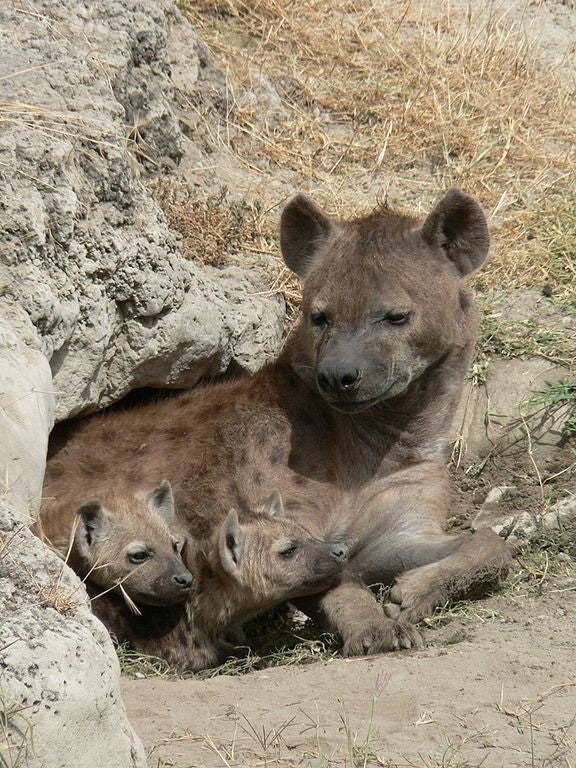This article was published in Scientific American’s former blog network and reflects the views of the author, not necessarily those of Scientific American
Spotted hyenas may be the chattiest carnivores on the planet. They whoop, rumble, low, and laugh, announcing their presence wherever they go. But what do all these calls mean?
Zoologist Kay Holekamp laid out the spotted hyena repertoire in a 2011 New York Times field journal. So far as we humans are able to understand, each category of call carries a general meaning that can be modulated by the sender to varying effect. Spotted hyenas low when they want to team up, alarm rumble to raise a red flag to approaching danger, and groan to greet cubs at a den, who then squitter to demand milk from mom. And their trademark giggle? That’s nervous laughter. Spotted hyenas usually titter when they’re being attacked, harassed by another member of their clan, or are frustrated.
But there are more details embedded in hyena calls than we usually pick up on. In a 2007 study, Holekamp, Kevin Theis, and colleagues reported that spotted hyena whoops – their haunting, long-distance calls – reflect details about the age, and sometimes sex, of the hyena sending the signal. By looking at the acoustic details of 117 whoop bouts from 60 different hyenas, the researchers were able to discern that whoops become deeper with age and that the calls of non-juvenile males and females could be distinguished from each other (perhaps because the larger females have bigger chests that give them a deeper pitch). If you were a hyena, your whoop would carry essential information about who you are.
On supporting science journalism
If you're enjoying this article, consider supporting our award-winning journalism by subscribing. By purchasing a subscription you are helping to ensure the future of impactful stories about the discoveries and ideas shaping our world today.

Mother hyenas grunt to draw their cubs out, and those cubs “squitter” to beg for milk. Credit: Budgiekiller Wikipedia (CC BY-SA 2.5)
A hyena’s giggle is even more distinctive. A 2010 study by Nicolas Mathevon and colleagues on 695 giggles made by the University of California, Berkeley’s captive hyena clan (shuttered last year, sadly) found that the carnivore’s characteristic laugh carried cues about the sender’s age, status in the clan, and perhaps individual identity. This is all critical information for a social predator. If you’re going to work as a group, you need to know who’s talking as well as what’s being said.
And while some of these details might be lost on other species, hyena chatter can carry critical information for their carnivorous neighbors. Cheetahs, zoologist Sarah Durant discovered through playback experiments, will leave an area if they hear the sounds of lions or hyenas. In fact, Durant observed, the sleek cats were even less likely to go on the hunt after hearing the calls from their competitors. What was the point of bringing down dinner if a hyena might swoop in and steal it?
Lions are another matter. Despite their regal reputation, these burly felids often play the part of kleptoparasites. Lions have no qualms about bullying weaker carnivores off their kills, and, as argued by Hugh Webster and colleagues after playback experiments, lions will eavesdrop on the calls of other species to zero-in on an easy meal. Wild dog calls always generated interest, the researchers found, but male lions or mixed groups of male and female lions would also approach spotted hyena vocalizations in the hope of some grub on the go. At least hyenas can mitigate the risk of losing their lunch. One population in Zimbabwe started traveling in mid-size groups, rather than forming large foraging parties, in response to an influx of lions.
Short of a Babel fish, we’ll never be able to translate hyena giggles down to the level of “Hey! That’s my wildebeest leg!” or “Get lost, you mangy lion!” But hyenas don’t need the broadened vocabulary we have to keep their clans together. Their set of a dozen or so calls seems to suit them fine, with each hyena adding their own unique voice to the chorus.
References:
Durant, S. 2000. Living with the enemy: avoidance of hyenas and lions by cheetahs in the Serengeti. Behavioral Ecology. doi: 10.1093/beheco/11.6.624
Mathevon, N., Koralek, A., Weldele, M., Glickman, S., Theunissen, F. 2010. What the hyena’s laugh tells: sex, age, dominance and individual signature in the giggling call of Crocuta crocuta. BMC Ecology. doi: 10.1186/1472-6785-10-9
Theis, K., Greene, K., Benson-Amram, S., Holekamp, K. 2007. Sources of variation in the long-distance vocalizations of spotted hyenas. Behaviour. doi: 10.1163/156853907780713046
Webster, H., McNutt, J., McComb, K. 2010. Eavesdropping and risk assessment between lions, spotted hyenas, and African wild dogs. Ethology. doi: 10.1111/j.1439-0310.2009.01729.x
[This piece was originally posted at National Geographic.]